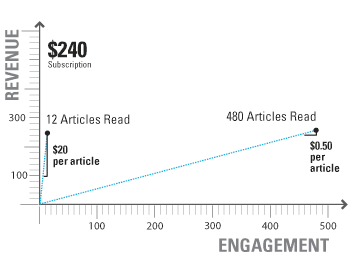Last week, Scout Analytics announced research concluding that aligning engagement and revenue provides a 20-30 percent uplift potential for paid-content publishers. After fielding a few questions on the research, I thought it might be worthwhile to explain some of the methodology here in the blog. This blog entry will address the following questions:
- What is engagement?
- What is unit cost of engagement and how do you calculate it?
- Why is calculating unit cost important?
First, what is engagement? In paid content, engagement is consuming content (e.g., reading an article, downloading a report). Engagement can be measured at an individual level (e.g., number of articles read by a single user) or at an organizational level (e.g., number of articles read by a group of users).
What is the unit cost of engagement? Unit cost of engagement is the transformation of subscription price from units of time (i.e., length of term) into units of engagement. The unit cost of engagement is the price paid by a subscriber for consuming one piece of paid content (e.g., reading one article). 
How do you calculate unit cost? The simple answer is to take the total revenue from a subscription and divide it by the total measure of engagement (e.g., total number of articles read) during the term. The chart below illustrates the unit cost of engagement. In this chart, two subscribers pay the same annual fee of $240 to a paid-content publisher. The first subscriber on average read one article a month during the term or $20/article (i.e., 12 articles for the price of $240). The second subscriber on average read two articles per workday during the year or $0.50 per article (i.e., 480 articles for the price of $240).
Why is calculating unit cost important? Understanding unit cost of engagement is critical to maximizing the lifetime value of a subscriber. When signing up for a new service, subscribers mainly think about subscription fee by length of term. At renewal time, subscribers evaluate whether the service is valuable enough to continue by considering what the subscription costs vs. how much the content was used. As a result, those subscribers who use the service significantly less than other subscribers have been proven statistically more likely to churn. And, those subscribers who use the service significantly more than other subscribers have been proven statistically more likely to accept a price increase.
In a simplistic revenue model where every subscriber pays the same price for the same access, comparing usage to revenue is not that interesting, but I haven’t met any publishers with a simplistic revenue model. The reality is that most paid-content publishers have a wide range of licensing options and variable pricing where simply comparing usage without factoring revenue leaves a significant amount of revenue untapped.
For subscribers, thinking about unit cost of engagement is usually an implicit, qualitative assessment, but for publishers, the analysis can be quantified and acted upon. I’ll cover that in the next post.






